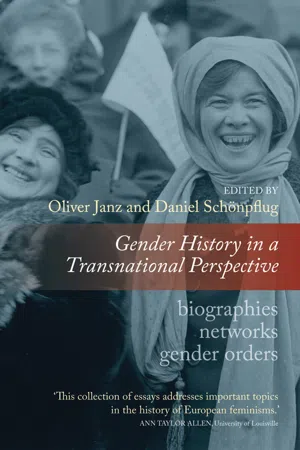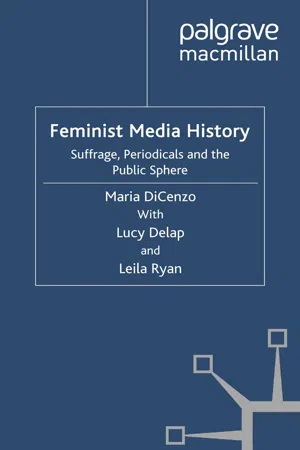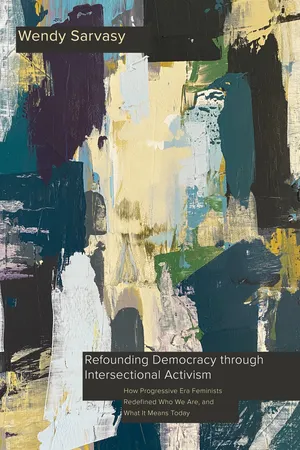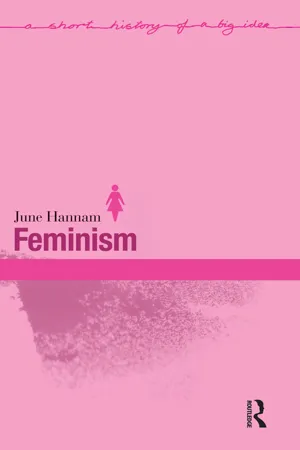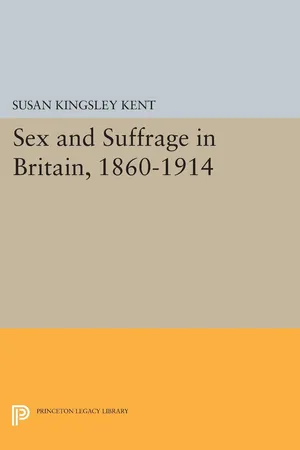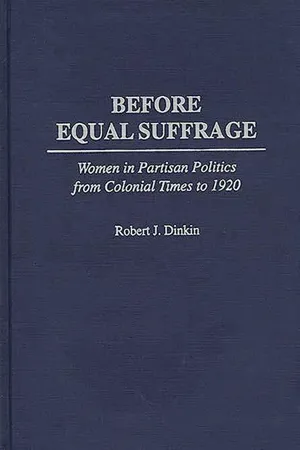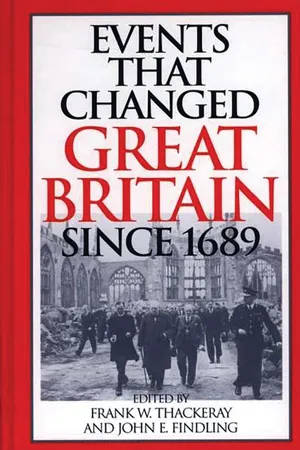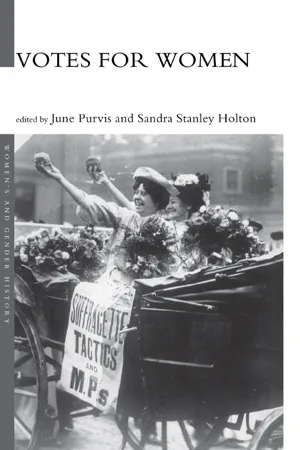Politics & International Relations
Suffrage Movement
The suffrage movement refers to the historical struggle for the right to vote, particularly for women. It encompassed various campaigns, protests, and advocacy efforts aimed at achieving political enfranchisement for women. The movement played a crucial role in advancing gender equality and expanding democratic participation, ultimately leading to the granting of voting rights to women in many countries around the world.
Written by Perlego with AI-assistance
Related key terms
1 of 5
10 Key excerpts on "Suffrage Movement"
- eBook - PDF
The Woman Suffrage Movement in America
A Reassessment
- Corrine M. McConnaughy(Author)
- 2013(Publication Date)
- Cambridge University Press(Publisher)
30 The Woman Suffrage Movement in America process. Their specific tools of influence have certainly changed over time – in the time of woman suffrage politics, for example, the major political parties directly controlled decisions such as ballot wording and distribution and the location of polling places. Although some of their previous specific powers have been transferred to the state, to this day no other political organizations stand ready to mobilize electorates in favor or against a cause as readily as parties. This electoral influence is of particular importance because voting rights changes at the state level so often require a constitutional amendment that must be ratified by the existing electorate. The costs of educating and mobilizing the public to actually vote in support of the proposed change are formidable, and difficult for the disfranchised to bear. In contrast, the party apparatus, designed to influence elections, could be a most effective ally or formidable obstacle in achieving the necessary public vote. No matter the influence of parties, however, it is still through legislatures that suffrage provisions must generally pass. What is most important to note about the legislative process, itself, is how difficult it makes the provision of new voting rights. In other words, placing suffrage politics inside legislative institu- tions imposes some important constraints. In the United States, at both the state and federal levels, legislative institutions in general make status quo protection easier than change, but particularly so in the case of voting rights. Because voter qualifications are generally defined by states’ constitutions, changes most often require the clearing of extra policy-making hurdles, including legislative super-majorities, passage in multiple consecutive legislative sessions, and final approval through public referenda. - eBook - PDF
Gender History in a Transnational Perspective
Networks, Biographies, Gender Orders
- Oliver Janz, Daniel Schönpflug(Authors)
- 2014(Publication Date)
- Berghahn Books(Publisher)
Firstly, these relationships manifested themselves as disagree-ments between historical actors about the ‘correct’ relationship between class and gender in the politics of women’s suffrage. Secondly, they be-came visible in how the establishment of the Women’s International and the unequal development of suffrage politics and the fight for suffrage in Europe related to each other. And thirdly, there was a close relationship between the socialist internationalism of women and its internationalist neighbours, namely the Second International and the organised women’s suffrage internationalism of the International Woman Suffrage Alliance (IWSA). Political struggle and contention in these three areas, and their interaction, contributed decisively to the birth of the Women’s Interna-tional and its self-positioning – particularly on the question of suffrage – within the international reform movements of workers and women in early-twentieth-century Europe. Issues at Stake Social democracy in the European-international context of the early twentieth century was embroiled in extensive debates on the question of suffrage and suffrage politics. This was a reflection of the fact that in a A Struggle over Gender, Class and the Vote • 103 number of countries, within the context of intensifying overall political struggle for suffrage, the issue of women’s suffrage grew in importance. In the summer of 1906, Finland (a country which enjoyed autonomy within the Russian Empire) became the first country in Europe to introduce gen-eral and equal suffrage for women and men. 4 One of the most important issues in the socialist debate was the posi-tion social democrats and their parties in different countries should take regarding the struggle for women’s suffrage, and the tactics they should develop in this regard. - eBook - PDF
Feminist Media History
Suffrage, Periodicals and the Public Sphere
- M. DiCenzo, Leila Ryan, Lucy Delap(Authors)
- 2010(Publication Date)
- Palgrave Macmillan(Publisher)
Lee Ann Banaszak provides a comparative analysis of suffrage campaigns in the United States and Switzerland (1996). The British Suffrage Movement (and early women’s movements in Britain generally) have not received this kind of sustained attention by social movement scholars. Key studies by Olive Banks, Faces of Feminism (1981) and Becoming a Feminist (1986), analyze early British feminism as a social movement, but more in terms of historical sociology than within the specific framework or critical vocabulary of social movement theory. Media have not been central to the concerns of these studies, except insofar as they provide sources of information. A notable exception is Louise Ryan’s work on the Irish Suffrage Movement which draws on social movement theory (2001) and grows out of her work on the Irish suffrage press (1996). This section aims to offer a more general overview of concepts rele- vant to the analysis of early women’s movements. Recent developments and synthetic approaches in the field of social movement theory pro- vide a useful point of entry and encourage multi-faceted analyses, even if the multiple and overlapping dimensions complicate the process of exposition. We begin with two general working concepts and assump- tions within which to situate our concerns with feminist media and the factors that relate to their examination. First, our study is premised on the idea of ‘contentious politics’ or ‘contentious collective action.’ The raison d’etre of social movements is to bring a set of issues or grievances to be heard, recognized, and addressed in the public sphere. Sidney Tarrow argues it is a necessary starting point for understanding social movements: The irreducible act that lies at the base of all social movements and revolutions is contentious collective action ... . It [collective action] becomes contentious when it is used by people who lack regular access to institutions, act in the name of new or unaccepted claims - eBook - PDF
Refounding Democracy through Intersectional Activism
How Progressive Era Feminists Redefined Who We Are, and What It Means Today
- Wendy Sarvasy(Author)
- 2024(Publication Date)
- Temple University Press(Publisher)
Inspired by Addams’s actions and reflections, I have built a concept that weaves intersectional versions of the politics of presence into an insurgent or movement-based type of electoral politics. This concept of electoral poli- tics of presence breaks with the interest group politics interpretation of the Suffrage Movement by assuming that the egalitarian suffragists were acting as social movement bridgers. 11 They were seeking a refounding of democracy. Since the formulation of the vote as a tool for achieving narrow social reforms could reinforce the interest group politics framing, in the next section, I re- cover how egalitarian suffragists embedded the vote as tool within a vision of a peaceful political revolution. Egalitarian Suffragism: Tool for Social Justice and Political Revolution The egalitarian tendency within the late suffrage campaign, according to his- torian Aileen Kraditor, emerged when settlement house workers made wom- en’s suffrage a priority. She argues that they reinfused suffragism with “[t]he egalitarianism” present when suffragism first emerged in the nineteenth cen- tury out of the abolitionist movement. 12 In addition, historian Lisa Materson shows that African American suffragists kept alive the egalitarian promise when they linked women’s suffrage to the Reconstruction Amendments. 13 Further, immigrant Jewish labor and socialist activists insisted on the egalitar- ian version of suffragism by fusing it to the politics of gendered class struggle. Taken together, the three origins of egalitarian suffragism led to an intersec- tional framing of “votes for women,” the popular slogan of the late suffrage period. As a result, the egalitarian suffragists defined themselves in opposi- tion to early twentieth-century mainstream suffrage leaders, who assumed that the pursuit of gender political equality could be separated from ques- tions of white supremacy, nativism, and class inequality. - Available until 4 Dec |Learn more
- June Hannam(Author)
- 2013(Publication Date)
- Routledge(Publisher)
Chapter 3 Women’s suffrage, 1860s–1920sWHY WAS WOMEN’S SUFFRAGE such a controversial issue and why did it take so long to achieve? Why did women want the vote so badly and why has it had such a central place in histories of feminism? To what extent did suffrage campaigns make a difference to the achievement of the vote? Both supporters and opponents believed that women would use the vote to bring about social and political change. But more than that contemporaries feared that if women had a political voice then the ‘traditional’ relationship between men and women in the family and the workplace would come under threat. Feminists certainly recognized the symbolic importance of the vote. It signified the possibility of women acting together across national boundaries to transform the world in which they lived. This helps to explain why it evoked such strong feelings on both sides.Sex was a key factor in deciding who should, or should not, be included in the franchise. The demand for women’s suffrage, therefore, highlighted women’s common interests and raised the possibility of a ‘universal sisterhood’. It was the one issue that brought women from a variety of backgrounds together in organized groups and in highly public campaigns. This in turn could foster a sense of solidarity among women as they faced intransigent opposition to their cause. Organized Suffrage Movements developed first in the ‘liberal democracies’ of Europe, North America and the white-settler colonies of Australia and New Zealand and in most cases reached a peak in the decade before the First World War. Given their size and ‘militancy’, the British and American movements took centre stage among contemporaries and also in later suffrage histories. But this should not lead us to neglect Suffrage Movements in other countries. They had their own priorities, aims and tactics which need to be recognized and should not simply be viewed through the eyes of Anglo-American campaigners. - eBook - PDF
- Susan Kingsley Kent(Author)
- 2014(Publication Date)
- Princeton University Press(Publisher)
. . raising the position of women from absolute subjection to free citizenship." She recognized that the absolute subjection of women to men contained the notion that women's sexual functions were valued only insofar as they served the pleasure of men. After the vote was won in 1918, she noted with satisfaction that "the lives of women in childbirth were taken account of by Parliament in quite a different spirit directly women acquired the status of citizens." 82 The vote also symbolized for women self-determination and choice. "It is, after all," wrote Hale, "a fragment of sover- eignty." 83 Enfranchisement represented the right of women to -211 - CHAPTERVII determine for themselves their identity, their roles, their inter- ests, and their actions. As Cicely Hamilton observed in 1912, the Suffrage Movement reflected women's "efforts to overthrow the barriers that have so far hemmed them in, to discover their own needs, strengths, weakness and purpose in life—to ascertain, in short, the essentials of their own identity." 84 The prime object of militancy, Teresa Billington-Greig agreed, consisted of "the assertion of the woman's right to be herself, the undermining of the customs, habits, and conventions, which . . . bar the way to the real emancipation of women." 85 In demanding the vote, women demanded that men "love women for what they are, not what it amuses men to think they are." 86 Civic personality con- stituted the first step in the individual woman's formation of personal identity, for the vote "is the symbol and medium of human will and human power shaping the circumstances and conditions of the outside human world," Emmeline Pethick Lawrence maintained. 87 "Through the vote," Christabel Pank- hurst proclaimed, "women will gain a new confidence in them- selves and a real power to help themselves." 88 It would enable them to develop a sense of dignity based on personal worth rather than on their relationship to men. - eBook - ePub
Women's Suffrage in Asia
Gender, Nationalism and Democracy
- Louise Edwards, Mina Roces(Authors)
- 2006(Publication Date)
- Taylor & Francis(Publisher)
In highlighting the unique features of women's Suffrage Movements this book points to new areas of inquiry for future research and hopes to stimulate debates about such ‘uniqueness.’ There are some countries that we have not been able to include: Malaysia, Singapore, Cambodia and Laos for example. Further research could also be done on the local Suffrage Movements within the various countries. In the Philippines there was a lively Suffrage Movement in the province of Cebu where women writers published articles in their local newspapers written in their local language. Since we focus on the democratic exercise of power, this volume does not explore informal power and kinship politics — important in the analysis of power in Asia. But by exploring what is problematic about the Suffrage Movements in Asia, this book takes a step towards unsettling women's history from the ‘national’ histories of Asia.Notes
1 Rheta Childe Dorr, ‘April 26th Hearing before the Senate Suffrage Committee,’ The Suffragist , vol. 5, 66, 1917, 9.2 Ian Tyrrell, Woman's World, Woman's Empire: The Woman's Christian Temperance Union in International Perspective 1880–1930 , Chapel Hill: University of North Carolina Press, 1991, pp. 292–3.3 Leila Rupp, Worlds of Women: The Making of an International Women's Movement , New Jersey: Princeton University Press, 1997, p. 3.4 Rupp, ibid.; Caren Kaplan, Norma Alarcon and Minoo Moallem (eds), Between Woman and Nation: Nationalisms, Transnational Feminisms, and the State , Durham and London: Duke University Press, 1999.5 Carole Pateman, ‘Three Questions about Womanhood Suffrage,’ in Caroline Daley and Melanie Nolan (eds), Suffrage and Beyond: International Feminist Perspectives , Auckland: Auckland University Press, 1994, p. 346.6 Ian Christopher Fletcher, Laura E. Nym Mayhall and Philippa Levine (eds), Women's Suffrage in the British Empire: Citizenship, Nation and Race , London: Routledge, 2000.7 Kumari Jayawardena, Feminism and Nationalism in the Third World , London: Zed Books, 1985, p. 2.8 Ibid., p. 8.9 Ibid., Chapter 1 .10 Louise Edwards, ‘Women's Suffrage in China: Challenging Scholarly Conventions,' Pacific Historical Review , vol. 69, 4, 2000, 618.11 Yukiko Matsukawa and Kaoru Tachi, ‘Women's Suffrage and Gender Politics in Japan,’ in Daley and Nolan, op. cit., pp. 172–3.12 - eBook - PDF
Before Equal Suffrage
Women in Partisan Politics from Colonial Times to 1920
- Robert J. Dinkin(Author)
- 1995(Publication Date)
- Praeger(Publisher)
Chapter 7 Politics and the Suffrage Amendment For many decades, as we have seen, the woman Suffrage Movement had had at least some connection with partisan politics. Beginning in the late 1860s, the suffragists had offered to support either of the parties, promising everlasting allegiance to the one that would help them achieve the vote. They at times had participated in campaigns with the hope that the particular party would be grateful and reward them for their contribution. After a while, it had become evident that this strategy was not working: The parties, especially the Republican side, had benefited from women's efforts but had not provided any degree of reciprocation. Nevertheless, some suffrage advocates continued to back their favorite party, believing, as GOP activist J. Ellen Foster did, that this was the best alternative for women and would ultimately lead to their obtaining thefranchise.Yet the majority of suffragists, particularly those involved in the reunited National American Woman Suffrage Association (NAWSA) starting in 1890, chose to follow a nonpartisan approach and avoid making any political commitment. They insisted that neutrality was essential in gaining legis- lative support in the states or building a consensus in Congress for a constitutional amendment. But after 1912 a significant minority would reenter the partisan arena, and, instead of asking for favors, attempted to put pressure on the party in power to hasten passage of a suffrage amendment. As a result, many additional women were thrust into partisan politics via election campaigns, and although the plan as outhned did not fully succeed, it did have a catalytic effect on the process of securing the vote for all women. 124 Before Equal Suffrage This new strategy was made possible by the fact that many more women had recently become eligible voters in the western states. - eBook - PDF
- Frank W. Thackeray, John E. Findling, Frank W. Thackeray, John E. Findling(Authors)
- 2002(Publication Date)
- Greenwood(Publisher)
Sue- Sinn Fein and the Suffragettes 123 cess in one area did not necessarily mean success in the others, but all of these issues were inextricably linked nonetheless. The movement for women's suffrage implied something of a social revo- lution by its very nature. It challenged contemporary ideas of male patriar- chy and dominance and led men to speculate on what the world was coming to. If the traditional relationship between the male and female sexes dissolved, what else could provide the kind of stability to which English- men raised in the nineteenth century had become accustomed? The work- ing classes had gradually achieved inclusion in the political system; to give more of them the vote did not represent a totally new change. To give any women the vote did. Even some women opposed women's suffrage, because they saw it as undermining the traditional role that women played in society, not because they viewed women as inherently inferior. The lack of support from any prominent male politician did not prevent women's suffrage on the national level from becoming a major political is- sue. However, it required an increasingly radical approach to make it so. Mrs. Emmeline Pankhurst and her daughters, Sylvia and Christabel, sup- plied this and emerged as the leaders of the "suffragette" movement. In 1903 Emmeline founded the Women's Social and Political Union (WSPU), an organization devoted to accelerating activity intended to call attention to the cause of women's suffrage. It built on the growing support for women's suffrage within the Liberal Party that had been achieved by the National Union of Women's Suffrage Societies (NUWSS), headed by Millicent Fawcett, which operated more in the mainstream liberal political tradition. Fawcett continued to expand the membership and revenues for the NUWSS, while supporting the role of the militant WSPU in calling at- tention to the cause. - eBook - ePub
- Sandra Holton, Dr June Purvis, June Purvis, Sandra Holton, Dr June Purvis, June Purvis(Authors)
- 2002(Publication Date)
- Routledge(Publisher)
12 ‘A SYMBOL AND A KEY’ The Suffrage Movement in Britain, 1918–1928 Johanna AlbertiWhen we strove with most passion for the vote, we sought it not for itself only, but as a symbol and a key.1INTRODUCTIONIn February 1920, the first issue of a journal The Woman’s Leader was published. The paper was the successor to The Common Cause although it was not the official organ of the National Union of Societies for Equal Citizenship (NUSEC), the renamed and reconstructed National Union of Women’s Suffrage Societies (NUWSS). The leader in this first issue, under the title ‘The Woman’s Leader and the Task before It’, looked back at the years 1900–1914 when the whole of the women’s movement was concerned with the ‘breaking down of one especial barrier’, a barrier so powerful that the movement became ‘a strong and at moments a torrential stream’ which had in the end loosened that barrier. The concentrated effort required to break down the barrier against the women’s parliamentary vote meant that the movement had flowed in those years in a single channel, but, the leader asserted: ‘Now, again, the women’s movement is a double stream.’ The first of these two main streams, ‘which sometimes flow separately and often intermingle’, was ‘an effort to break down barriers, the other an effort to expand into fresh life’. The first stream included ‘the struggle for the vote’ and ‘the struggle for equal opportunities in the professions and in industry’; to the second belonged the ‘development of women’s education, of women’s citizenship, and of women’s work’. The challenge now was to ensure that women working in different ways ‘did not lose sight of one another’. The writer of the article also identified a new generation of young women with a different perspective whom the paper intended to help, not only in ‘making their own lives, but in doing good service to their country and to humanity’.2
Index pages curate the most relevant extracts from our library of academic textbooks. They’ve been created using an in-house natural language model (NLM), each adding context and meaning to key research topics.

